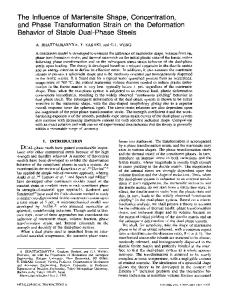Influence of creep of the material of inclusions on the stress concentration in the body
- PDF / 395,515 Bytes
- 7 Pages / 595.205 x 793.701 pts Page_size
- 33 Downloads / 363 Views
INFLUENCE OF CREEP OF THE MATERIAL OF INCLUSIONS ON THE STRESS CONCENTRATION IN THE BODY V. P. Sylovanyuk1, 2 and A. V. Revenko 1
UDC 539.3
We solve the problem of determination of the stress-strain state of an elastic plate with thin viscoelastic inclusion. The problem is reduced to a singular integrodifferential equation whose exact solution is obtained for the case of elliptic inclusion. Several creep kernels used to describe the rheological properties of the material of the inclusion are analyzed. The stresses acting in the inclusion and their concentration in the matrix in the vicinity of the inclusion are determined. Keywords: creep, inclusion, stress concentration, viscoelasticity, relaxation.
In the process of operation of structures and mechanisms made of contemporary and ordinary materials, it is often necessary to take into account creep. The operating and mechanical properties of numerous structural materials (concretes, high-molecular compounds, and materials operating at elevated temperatures) are functions of time. For the strength and serviceability analyses of the objects made of these materials, it is customary to use the theories of creep and long-term strength [1–3]. Foreign inclusions contained in almost all structural materials noticeably affect their strength. At present, the models taking into account the presence of inclusions and based mainly on the concepts of the theory of elastic bodies (matrix and inclusions) are available from the literature [4 – 7]. In the course of operation of structurally heterogeneous materials under long-term loads and extreme temperature conditions, it is necessary to take into account the phenomena of creep and relaxation. In what follows, we propose a model of bodies with inclusions taking account the viscoelastic behavior of the material of inclusions responsible for the stress concentration in the matrix. Statement of the Problem Consider an isotropic elastic plane with thin viscoelastic inclusion. The conditions of continuity of displacements and stresses are satisfied on the contact surfaces of the materials. At infinity, the body is stretched or compressed in the direction of the y-axis by forces whose intensity is equal to p (Fig. 1). The stress-strain state (SSS) of the plate containing an inclusion is represented as the sum of the ground ( p, u y0 ) and perturbed ( σ *y , u*y ) SSS as follows: σ y = p + σ *y . The ground SSS is determined by the given distribution of stresses at infinity in the absence of inclusions, whereas the perturbed SSS is determined by the inclusion. The level of strains in the thin inclusion is given by the formula εy ( x, t ) =
uy ( x, t ) h( x )
,
(1)
1 Karpenko Physicomechanical Institute, Ukrainian National Academy of Sciences, Lviv, Ukraine. 2 Corresponding author; e-mail: [email protected].
Translated from Fizyko-Khimichna Mekhanika Materialiv, Vol. 45, No. 4, pp. 76–80, July–August, 2009. Original article submitted March 24, 2009. 1068–820X/09/4504–0555
© 2009
Springer Science+Business Media, Inc.
555
556
Data Loading...











